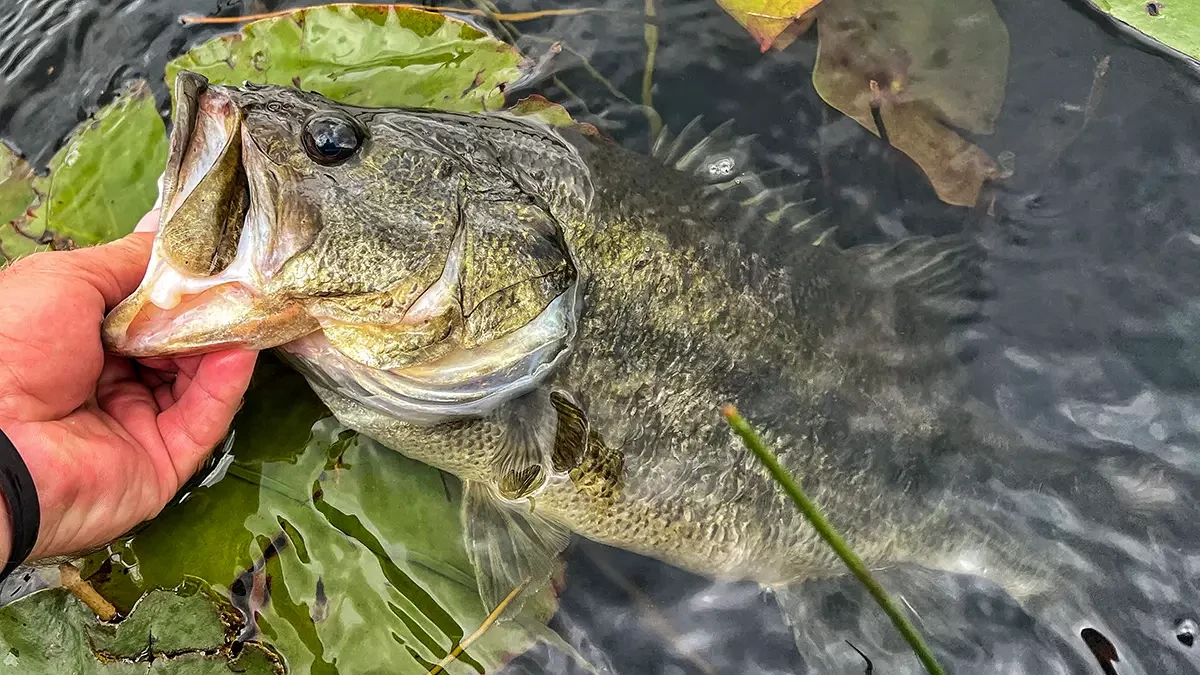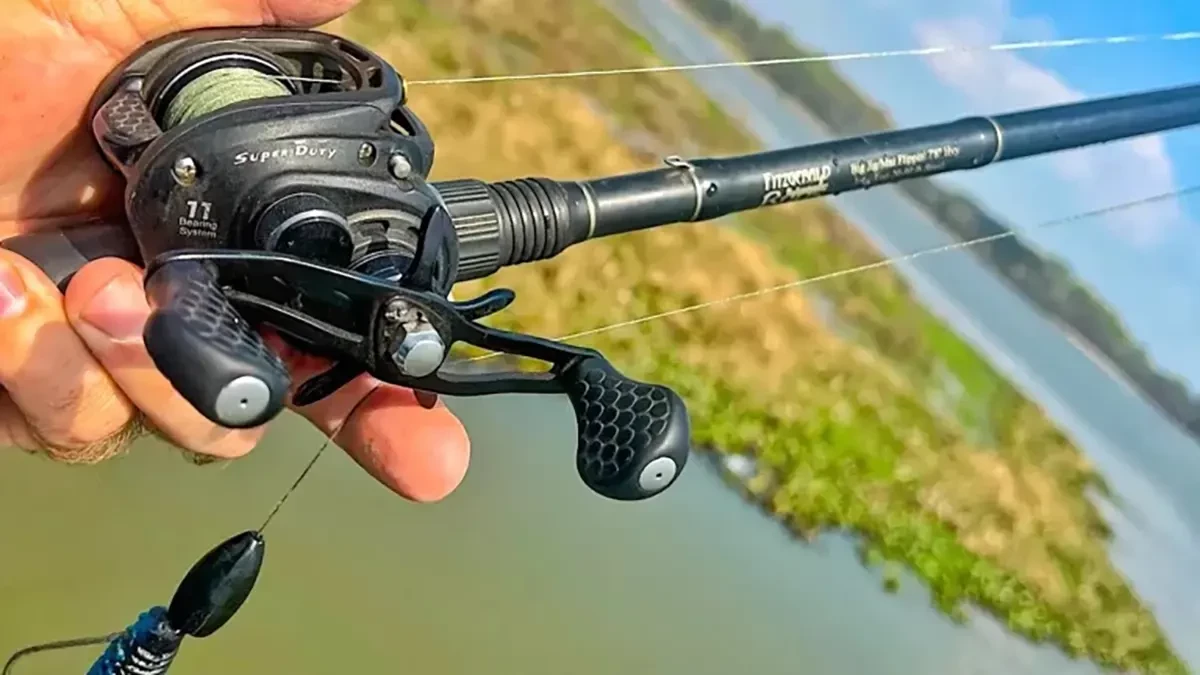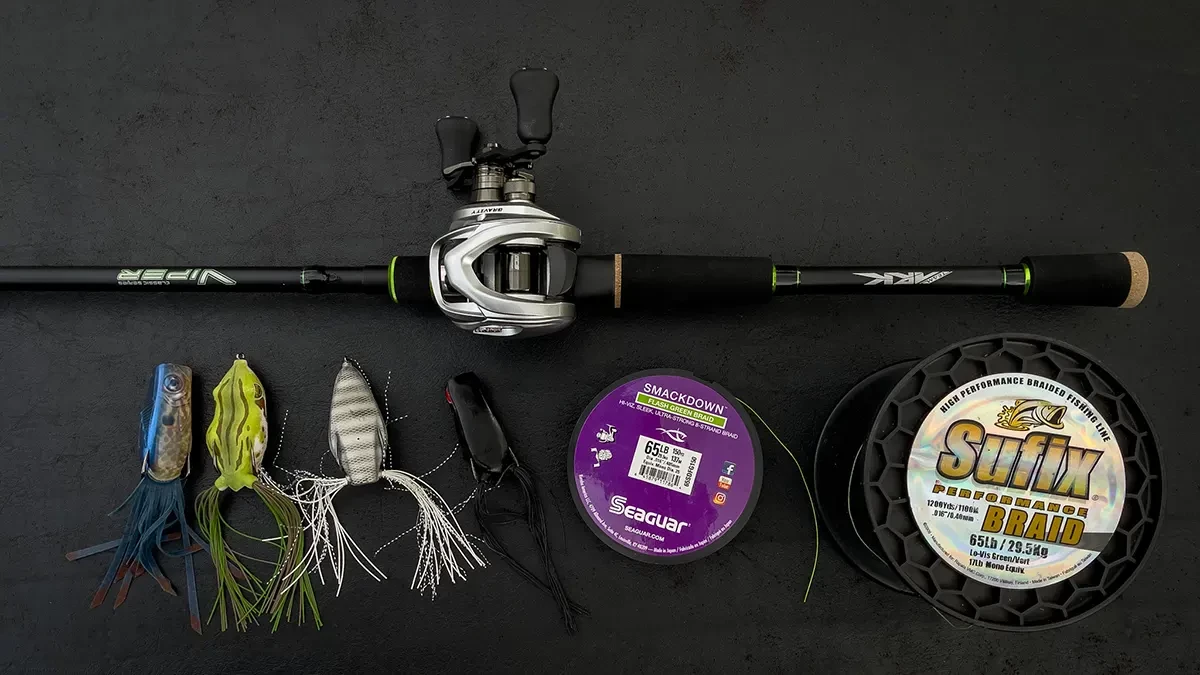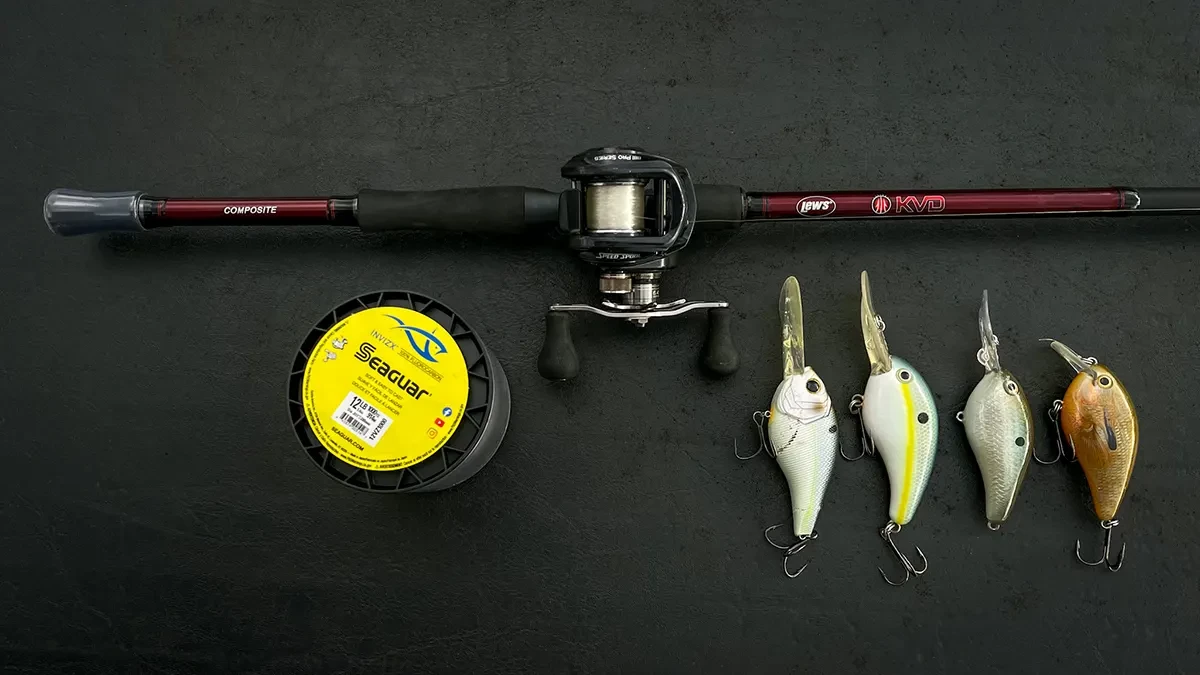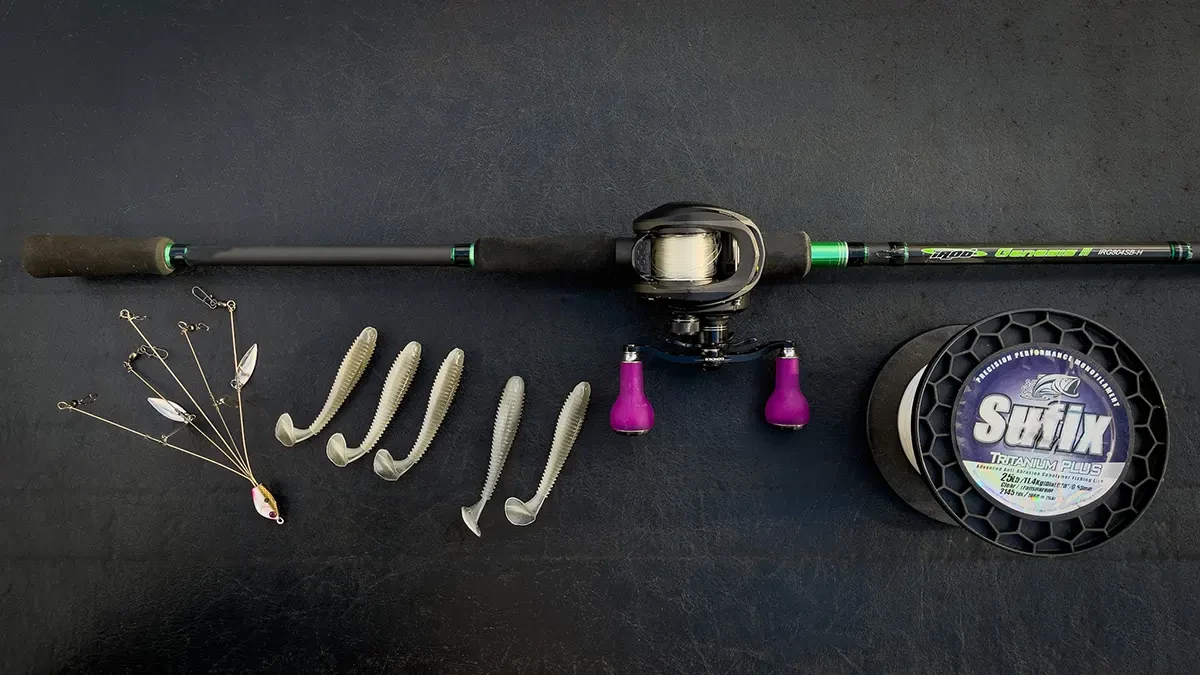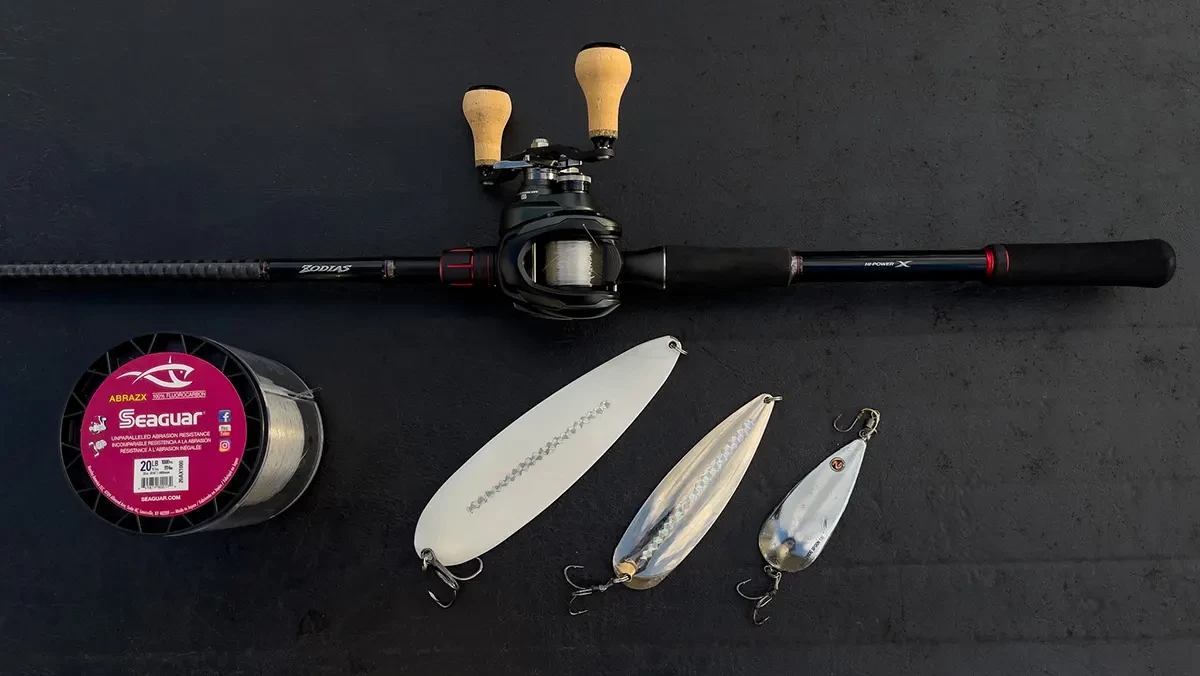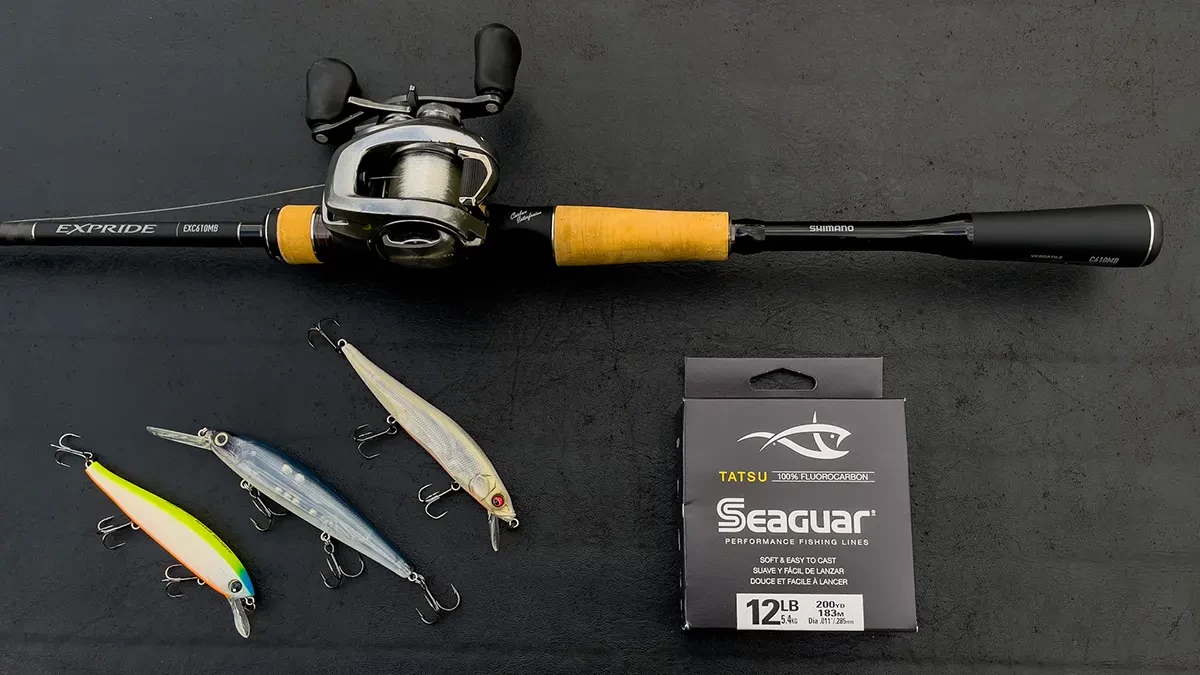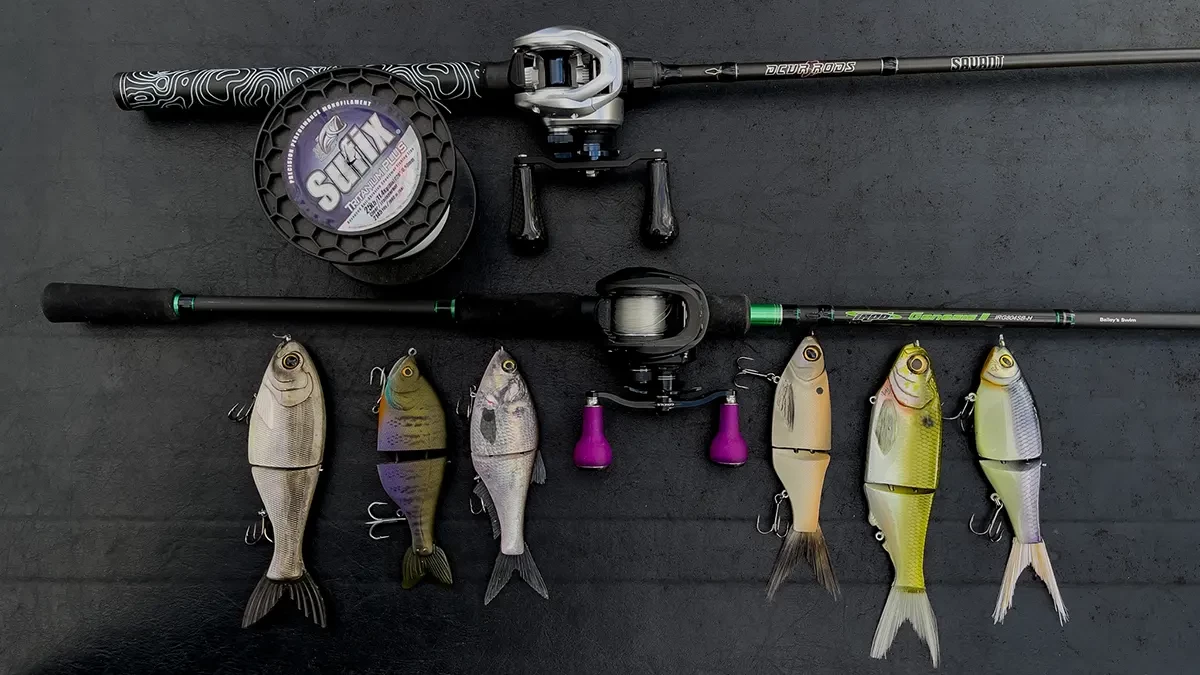Technique specific gear becomes increasingly vital to an angler’s arsenal as their skillsets evolve. You can do a lot with a 7-foot medium heavy casting rod paired with a 7:1 gear ratio reel and 15-pound fluorocarbon. It, however, is nowhere near the right setup for punching, glide baits, flutter spoons, frogging and it would make a drop shot mighty hard to fish. So we thought we might go through some of the more niche techniques and talk about the best bass fishing setups for each.
For each of these niche techniques, there’s a refined vein of specific gear. When it comes to these situations, the rod, reel and line matter as much or more to the overall presentation than the bait itself. A soft plastic rigged behind an ounce-and-a-half weight is useless if you don’t have the rod, reel and line necessary to pluck a bass out of the mat you’re punching through.
So we’re going to take a stab at outlining some simple recommendations for niche techniques outside the norm that work better with specific gear. At the onset, understand that this is not an exhaustive list as it focuses outside the normal just best bass fishing rods for the regular techniques. But this focuses on the best bass fishing setups for those outlier techniques that don’t have a lot of crossover with other techniques.
Punching Gear
Punching Setup Punching is one of the best ways to catch bass that are in and below thick, matted cover. Weights for this technique come in a wide range, but the terminology really switches from flipping and pitching to punching when you move into the ounce-and-up range. Weights between 1 and 2 1/2 ounces are used regularly for punching thick mats of vegetation.
These weights are trailed by some sort of compact soft plastic that is typically rigged on a straight shank flipping hooking in the 4/0 range. You’ll want to go with braided line in the 65- to 80- pound range, a strong baitcasting reel with a beefy drag and a near 8- foot flipping stick.
Punching Gear Setup Example:
- Lew’s Super Duty LFS Casting Reel 7.5:1
- Fitzgerald Flippin’ Rod 7’8″ Heavy Big Jig-Mat Flip
- Sufix 832 Braided Line Lo-Vis Green 65 pound
- VMC Tungsten Flippin Weights 1- and 1/2- ounce
- Top Brass Jumbo Peg-It
- VMC Ike Approved Heavy Duty Flippin Hook 4/0
- MISSILE Baits D-Bomb – Bruiser Flash
Frogging Gear
For hollow body frogs, the needs will not line up perfectly for every angler in every situation. Frogs can be used effectively in open water, overtop extremely thick mats of aquatic vegetation and several places in between. For all presentations and all anglers, braided line is a must.
In open water, or around sparse hard cover like docks and stumps, 30- pound braided line paired with a 7- foot medium heavy bait casting combo is likely sufficient. When fishing overtop thick mats of vegetation, you may want to go as high as 65- pound and even 80- pound test braid, paired with a super strong reel and a near 8- foot heavy action rod.
There’s a sweet spot in between for frog fishing where you can come as close to an all-around setup as possible. The rod will need to be short enough for accurate side-armed and roll casts when skipping a frog and light enough to easily twitch a frog quickly in open water. All while still being strong enough to haul bass out of fairly thick cover.
Recommended Frog Gear
- 7-foot, 2-inch heavy action Ark Viper rod
- Ark Gravity G7 Baitcaster
- Sufix 832 Braided Line Lo-Vis Green 40 pound
- 13 Fishing Trash Panda Frog
- Snag Proof Bobby’s Perfect Frog
- SPRO Dean Rojas Bronzeye Poppin’ Frog 60
- Strike King Popping Perch
Oversized Cranking Gear
As a good tipping point, we’ll use the term oversized crankbait to refer to any baits that dive more than 20 feet and/or weigh roughly an ounce or more. The Strike King 8XD and 10XD are good examples that meet both criteria, as are the 20.5 and 25.5 Berkley Dredgers. And the Strike King KVD Magnum Squarebill Crankbaits are good examples of baits that don’t dive as deep, but weigh a lot.
For these heavier crankbaits, which create a lot of resistance in the water, you’ll need specialized gear to cast and retrieve them. Look for a rod near 8-feet long with enough backbone to load up and heave these heavy baits, but a soft enough tip to allow for maximum action and quick runs from the fish near the boat. And the great cranking experts all agree, the power of a slower gear ratio reel is critical to help eliminate the fatigue generated by deep cranking for long periods of time.
Look for a slower reel with a big spool, so that you don’t compromise the speed of the bait. A reel in the 6:1 range that takes up close to 2-feet of line with each turn of the handle is best. Fluorocarbon line in the 15- pound range offers a great mix of benefits, with a smaller diameter to maximize depth and mid-range strength for casting these big baits and abrasion resistance on the retrieve.
Oversized Crankbait Gear Example:
- Lew’s Crankbait Casting Rod 7’10” 10XD
- Lew’s BB1 Pro Casting Reel 6.2:1
- Seaguar InvizX Fluorocarbon Line 15 pound
- Berkley Dredger Crankbaits 20.5 and 25.5
- Strike King Pro Model 8XD Crankbait
- Strike King 10XD Crankbait
- Strike King KVD Magnum Squarebill Crankbaits
Umbrella Rig Gear
When fishing an umbrella rig, you’ll definitely want technique specific gear. With some of these conglomerations of wire, jigheads and swimbaits nearing a half a pound, you’ll need beefy equipment to chuck an umbrella rig.
Start with close to an 8-foot heavy action rod with 50-pound braided line, or 20- pound fluorocarbon. You have to be careful with whatever line you choose. If you try to really cast hard to launch an umbrella rig, your line may catch in your reel midway though the cast and snap, resulting in a high-dollar headache as your umbrella rig sails through the air untethered before plummeting to the bottom.
Instead, make lob casts, letting the heavy action rod load up in the back cast and then heaving the bait. Slower gear ratio reels help with fatigue of reeling in these bulky balls of baits. And the slower reels will help prevent you from fishing too quickly, keeping the umbrella rig down in the strike zone longer.
Umbrella Rig Gear Example:
- iRod Genesis III Bailey Swim Casting Rod
- Lew’s Super Duty 300 Reel
- 20-pound Sufix Pro Mix
- Gomexus Handle
- Yum Flash Mob Jr.
- Strike King Rage Tail Swimmers
Flutter Spoon Gear
Flutter spoons can easily weigh more than a 1/4 pound. And we’re not talking McDonald’s quarter pounder with cheese. We’re talking 4 ounces of raw and heavy metal that would make Ozzy Osbourne blush. For these spoons weighing between 1 and 4 ounces, you’ll want to use a fairly long, heavy action rod with a moderate fast tip, and preferably one having a long handle.
The longer handle helps when lobbing and working the bait. The length and strength of a 7- and 1/2- foot heavy action rod helps when casting and working this bait as well, and when setting the hook. A fast gear ratio reel in the 8:1 range will also aid in taking up line quickly between pops, and when catching up to fish to set the hook. And 20- pound test fluorocarbon works well since it sinks and has minimal stretch.
Flutter Spoon Gear Example
- Shimano Zodias 7-foot, 9-inch XH Rod
- Shimano Curado
- Gomexus Oversized Handle
- Seaguar 20-pound AbrazX
- Nichols Ben Parker Magnum Flutter Spoon
- River2Sea WorldWide Spoon
Jerkbait Gear
It’s easiest to work a jerkbait with your rod tip down. In order to be able to do this without the tip breaking the water’s surface, it’s a good idea to go with a shorter rod. This is not a one size fits all scenario, as the necessary length depends on the height of the angler. But a 6- foot, 8- inch medium to medium heavy action baitcasting rod is a good place to start for an angler shorter than 6- feet tall.
Using a midrange gear ratio reel in the 6.5:1 arena helps ensure you won’t take up too much line between twitches and overpower the lure. The line selection can vary widely depending on the depth you’re fishing and the cover you’re fishing around, but 10-pound test is a pretty safe starting point if you’re wanting to fish a jerkbait 3- to 6- feet deep in open water.
Jerkbait Gear Setup Example
- Shimano Expride Jerkbait Rod
- Shimano Bantam MGL Casting Reel
- Seaguar 10 to 12-pound Tatsu Fluorocarbon
- Megabass Ito Vision 110 Jerkbait
- Yo-Zuri Rip Baits
- Strike King KVD 300 Jerkbait
- Berkley Stunna Jerkbait
Glide Bait Gear
Glide baits come in a wide range of sizes, from small 3- inch swimbaits to monster baits measuring more than a foot and weighing more than a pound. For the purposes of building a good all-around glide bait rod combo, we’ll stick to baits in the 6- to 9- inch range, or those weighing 2 to 4 ounces.
A near 8- foot heavy action rod with a long handle and a 300 size reel in a 7:1 gear ratio works really well. This action rod loads up to help heave these heavy baits, and the length and strength make for solid hooksets at the end of long casts.
If you’re wanting to fish your glide bait high in the water column, using a 25- pound monofilament line (which floats) will help you do that. But for most applications, the low-stretch and sinking characteristics of 20-pound test fluorocarbon line make it the best choice.


